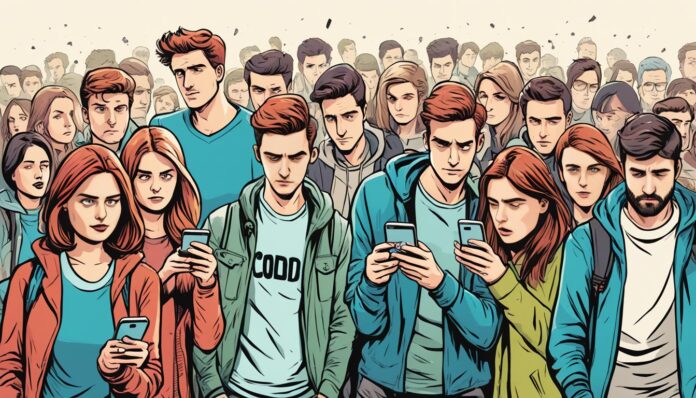
In many American homes, the debate over screen time is intense. My 2-year-old niece wants an iPad as soon as she wakes up. If she doesn’t get it, she throws a big tantrum. As her aunt, I feel helpless against these devices, trying to balance her growth with the constant tech distractions.
This technology’s impact on kids is worrying. High rates of depression, anxiety, self-harm, and suicide in Gen Z link back to smartphones and social media. These devices have changed how our kids grow socially and mentally. The constant use of these devices is causing problems like social anxiety, sleep issues, and addiction.
Key Takeaways
- The battle over screen time is already raging in households with young children.
- Alarming rates of mental health issues like depression and anxiety have been linked to the pervasive influence of smartphones and social media.
- Smartphones have “rewired” the way children develop socially and neurologically, leading to problems like social anxiety, sleep deprivation, and attention fragmentation.
- The current generation of “digital natives” is grappling with the unintended consequences of constant connectivity and smartphone addiction.
- Striking a balance between technology and healthy childhood development is a growing challenge for parents and caregivers.
The Screentime Battles Begin Early
The digital age has brought a new challenge for parents. They now face constant battles over screen time with their young kids. Smartphones and tablets are everywhere, making it hard for parents to limit their toddlers’ and preschoolers’ screen time.
Anecdotal Evidence of Smartphone Obsession in Toddlers
A parent shares their story about their 2-year-old niece. She won’t eat or do anything else until she gets her iPad. This shows how young kids can become addicted to screens.
Screens as a Coping Mechanism and Digital Pacifier
Parents worry about screens being used as a way to cope and distract their kids. Instead of sweets, the child prefers the iPad for comfort. This raises concerns about the effects of too much screen time on young kids.
Dealing with screen time is a big issue for parents. They need to be careful as technology’s impact on young minds grows. It’s important to understand the risks and find ways to manage screen addiction in kids.
The Anxious Generation: Rewiring Childhood
Research shows a worrying link between smartphones and the mental health of Generation Z. Jonathan Haidt, a social psychologist, talks about this in his book “The Anxious Generation.” He says the shift from playing to being on phones has changed childhood. This change has led to more mental health issues like anxiety, depression, self-harm, and suicide.
The Impact of Smartphones on Gen Z
Haidt’s studies show that teens’ mental health got worse in the early 2010s. This was after a period of getting better. This decline matches the time when smartphones and social media became more popular. Now, many college students wish platforms like TikTok and Instagram didn’t exist. They feel the constant need to be connected and compare themselves to others is bad for their mental health.
Toward a Healthier Childhood
To fix this, Haidt and experts suggest a few things. They suggest waiting to give smartphones to kids until high school, not allowing social media until 16, and banning phones in schools. These steps aim to help kids develop socially and neurologically. It might be hard to make these changes, but we need to act to help young people’s mental health.
“The transition from a play-based to a phone-based youth has ‘rewired childhood’ and disrupted social and neurological development, leading to a surge in mental health challenges.”
Is This Just Another Moral Panic?
Some think worries about smartphones and kids are just another “moral panic”. They compare it to past fears over TV, rock music, or video games. But, research by Jonathan Haidt shows smartphones and social media really do affect kids deeply.
Moral panics often come with new tech, and the stats on smartphones are scary. Depression and anxiety in young people have gone up a lot since 2011. The suicide rate for teens has also gone up since 2008. Research by Twenge shows teens are less happy and feel less connected as they spend more time online and less time with others.
“The smartphone has fundamentally altered the foundations of society and can have deleterious effects on people.”
This time, the criticism of smartphones is supported by science. As we see more harm to our health, we might start to think about changing how we use technology.
It’s easy to doubt another “moral panic”, but the facts are clear. Smartphones and social media could have big effects on kids’ lives. We need to change how we see technology to protect our kids.
Tech Companies Enabling Smartphone Addiction
Smartphone addiction is a big problem today, thanks to tech companies. They set age limits but don’t really check if people are old enough to use their apps. This lets kids and teens get hooked on their devices easily.
Lack of Age Restrictions and Enforcement
Apps like Facebook, Instagram, and TikTok say you must be 13 or older to use them. But, kids often lie about their age to get on these apps. The companies don’t check if people are really who they say they are. They care more about getting more users than keeping them safe.
Addictive Design Tactics Targeting Kids
What’s even scarier is how these apps are made to be super addictive, especially for young people. They use endless scrolling, push notifications, and special rewards to keep you coming back for more. These tricks mess with your brain’s reward system, making you use the app instead of doing fun things with friends or outside.
| Research Findings | Impact on Users |
|---|---|
| Problematic smartphone use linked to anxiety and depression | Smartphone addiction can make mental health problems worse, creating a bad cycle |
| Smartphone addiction associated with emotion regulation deficits | Users have trouble controlling their feelings and impulses, making addiction worse |
| Smartphone addiction related to academic performance decline | Too much screen time and distraction hurt school performance |
The tech industry wants to make money and keep users hooked. But this comes at a big cost to our health and society. It’s time for these companies to do better and protect young people from the harm of smartphone addiction.
Generation of Smartphone Zombies
In recent years, a “generation of smartphone zombies” has become a big worry. Kids and young adults are hooked on their screens, losing touch with the real world. This digital addiction is causing a lot of pain and suffering among the young. It’s making a generation of “failure to launch” boys and girls who are fragile and depressed.
It’s clear how big of an impact this tech obsession has. Germany has even named “smombie,” a mix of “smartphone” and “zombie,” as its Youth Word of the Year. People are talking about how “smombies” are a real issue, with stories of people getting hit by cars or needing to dodge them a lot.
This generation is growing up with social media and mobile tech always around. Older folks are trying to balance their jobs with being online all the time. But the next generation sees tech as just part of life, not an invasion. Some think that tech makes young people detached and socially awkward. But, tech and people are changing together.
The idea of “smombies” shows how society is adapting to new tech. We need to find a way to use technology’s good sides while avoiding its bad effects on our mental health, social life, and overall well-being.
“The deluge of misinformation during the recent pandemic showcased the negative impact of technology on public perception, with a surge in confusion and fear fueled by misleading news reports and stories accessed through smartphones.”
Striking a Balance with Healthy Tech Use
Parents face a big challenge in balancing their kids’ tech use and setting healthy limits. The idea of a “zero-tech” home or unlimited screen time doesn’t work well. Experts say a controlled screen time approach is best for kids.
Avoiding Extremes: Zero Tech vs. Unlimited Access
Banning all tech might make kids more obsessed when they do get to use it. On the other hand, too much screen time harms their brains, sleep, mental health, and grades. Finding a balance is key to keeping kids healthy and happy.
Controlled Screen Time and Setting Boundaries
The American Academy of Pediatrics suggests screen time limits by age: no screens for kids under 18 months, one hour for 2-5 year olds, and educational content for the youngest. Waiting to give kids their own phones helps avoid dangers like bullying and bad content.
To use tech healthily, set clear screen time boundaries and tech-free zones at home. Talk with your kids, make rules together, and be involved in their online lives. This helps with digital wellness and tech moderation.

“Creating family tech rules collaboratively empowers kids and encourages them to adhere to guidelines.”
By balancing tech use and setting limits, parents can help kids have a good relationship with technology. This leads to strong connections and better well-being in the digital world.
Proposed Solutions and “New Norms”
Experts are worried about smartphone addiction and its effects on young people. They suggest “new norms” to tackle these problems. Social psychologist Jonathan Haidt believes these steps can lessen the negative impacts and make a healthier space for kids and teens.
No Smartphones Before High School
One idea is to wait until kids are in high school to let them have smartphones. With 97% of 12-year-olds in Britain already having a smartphone, Haidt thinks waiting can protect their childhood. Indeed, 77% of parents want to ban smartphones for kids under 16 by 2024.
No Social Media Until Age 16
Haidt also says kids should wait until they’re 16 to use social media. Most people agree, with 96% thinking 16 is the right age. The rise of social media has led to more mental health issues in teens, especially girls and boys.
School Phone Bans and Increased Outdoor Play
Haidt also suggests banning phones at school. More outdoor play and socializing without screens can help. With kids spending 5 hours a day on devices, these changes could make them healthier.
By setting these “new norms,” Haidt and others aim to support healthy growth, mental health, and real social connections. They want to reverse the bad effects of too much screen time.
Not All Screen Time is Bad
Excessive screen time can be a concern, but not all of it is bad. In fact, when used right, technology can help kids grow and develop. It’s all about using it in a way that’s good for the family.
Jonathan Haidt and Zach Rausch say families can use technology in a positive way. Watching movies together or playing games with others can be good for kids. The important thing is to avoid tech that makes us sit alone and miss out on real life.
Studies show problems mainly come from sites like YouTube and TikTok. These sites aim to keep us hooked for a long time. But, if used wisely, technology can teach, inspire creativity, and bring families closer.
“Not all screen time is bad. Families can engage in activities like watching age-appropriate movies together or playing games in real-time with friends and family members as a healthier form of technology use.”
Finding the right balance is key. Technology should add to our lives, not take away from them. By setting clear rules and choosing interactive activities, parents can help kids have a good relationship with tech from the start.
Reversing the Damage: A Deadline for Change
Excessive smartphone and social media use is harming us. Renowned psychologist Jonathan Haidt urges us to act fast. He wants us to stop letting phones control our kids’ lives. This call highlights the need for quick action to tackle mental health problems linked to digital devices.
But, many doubt if we can make a change. It’s hard to fight the pressure that makes young people use their phones all the time. Tech companies not wanting to set age limits makes it even harder to make a safer digital world for kids.
Yet, the situation is very urgent. Studies show that too much screen time harms our brains. It can lead to poor mental health and lower happiness. We need to change how we use technology to protect our mental health.
“We must act now to end the phone-based childhood and reverse the damage caused by technology overuse. The stakes are too high to ignore the growing crisis.”
We need a plan to fix this. Parents, teachers, and leaders must work together to make better technology habits. If we don’t, our kids’ future and the future of society could be at risk.

The task is big, but we can’t ignore it. By making smart changes in how we use technology, we can ensure a healthier future for our kids.
Conclusion
Smartphones and social media have a big effect on kids and their mental health. While they offer many benefits, the growing problem of smartphone addiction worries parents, teachers, and doctors. This issue needs attention from everyone.
Now, over 65% of people worldwide own mobile devices, with many using smartphones. This has changed how kids and teens connect with the world. It often leads to less face-to-face time, less physical activity, and less emotional health.
We must work together to find solutions to smartphone addiction. This could mean limiting smartphone use until kids are in high school, stopping social media until they’re 16, and promoting outdoor play. By doing this, we can help future generations use technology in a way that’s good for their health.
FAQ
What is the concern about the impact of smartphones on childhood development?
The author worries about the “Generation of Smartphone Zombies.” Smartphones and social media harm children, causing depression, anxiety, self-harm, and suicide in Gen Z. They’ve changed childhood, leading to social anxiety, sleep issues, and addiction.
What does the author’s 2-year-old niece’s behavior illustrate about smartphone addiction in young children?
The author talks about their 2-year-old niece who loves her iPad too much. She won’t eat or do anything else until she can use it. The niece is so focused on the screen, it’s her main comfort and reward, even more than candy.
This shows how young kids use screens as a way to cope and relax, which worries the author.
What does the book “The Anxious Generation” by Jonathan Haidt reveal about the link between smartphones and mental health issues?
“The Anxious Generation” by Jonathan Haidt shows a link between smartphones and mental health problems in Gen Z. Haidt, a social psychologist, shares studies that link smartphone use to mental illness.
How do the author and Haidt argue that smartphones have “rewired childhood” and disrupted development?
Haidt says smartphones changed childhood, causing social and brain development issues. This leads to anxiety, sleep problems, and addiction.
Why does the author believe the impact of smartphones and social media on childhood development is more significant than previous technological changes?
The author thinks smartphones affect kids more than past tech changes. Haidt and others show strong evidence of this. They argue it’s not just another worry, but a real issue.
How are tech companies responsible for the smartphone addiction epidemic?
Tech companies are mostly to blame for smartphone addiction. They make rules against kids using their services but don’t enforce them. Their products are designed to be addictive, especially for kids, affecting their development.
What are the author’s concerns about the emergence of a “generation of smartphone zombies”?
The author fears a “generation of smartphone zombies” is forming. Kids and young adults are too into their devices, missing out on real life. This addiction causes a lot of pain and problems in young people.
What is the author’s recommendation for finding a balance with technology use for children?
The author doesn’t support extreme tech use or no tech at all. They suggest finding a middle ground. It’s hard for parents, but setting clear tech rules is key.
What are the “new norms” proposed in Haidt’s book to address the issues of smartphone and social media use among children and teenagers?
Haidt suggests four new rules: no phones before high school, no social media until 16, phones banned in school, and more real-world play for kids.
What types of screen time activities does Haidt recommend as healthier alternatives?
Haidt suggests better screen time like watching movies together or playing games with family. The problem is with platforms that aim to keep you hooked, like YouTube and TikTok, and online social media that cuts into real-life interactions.
